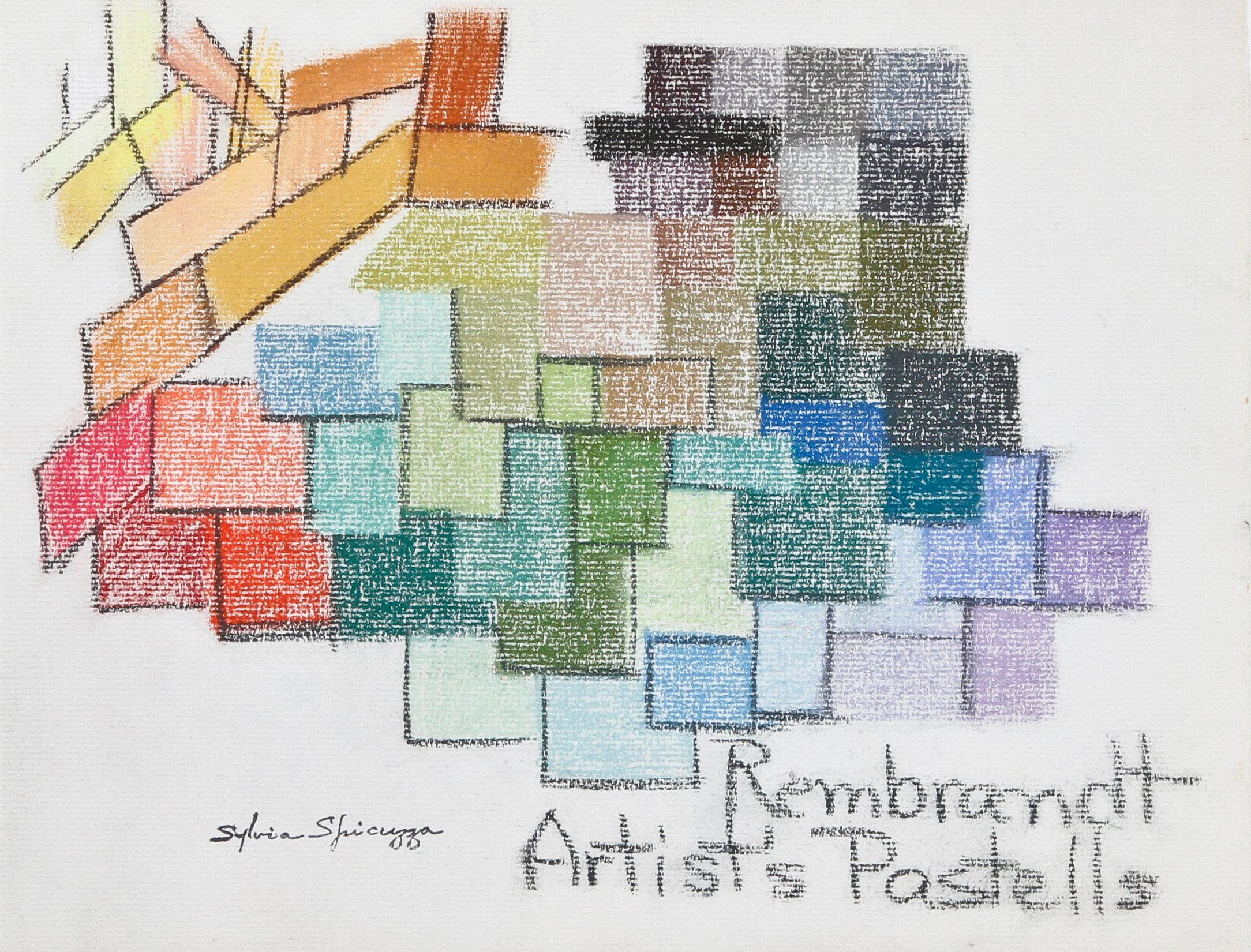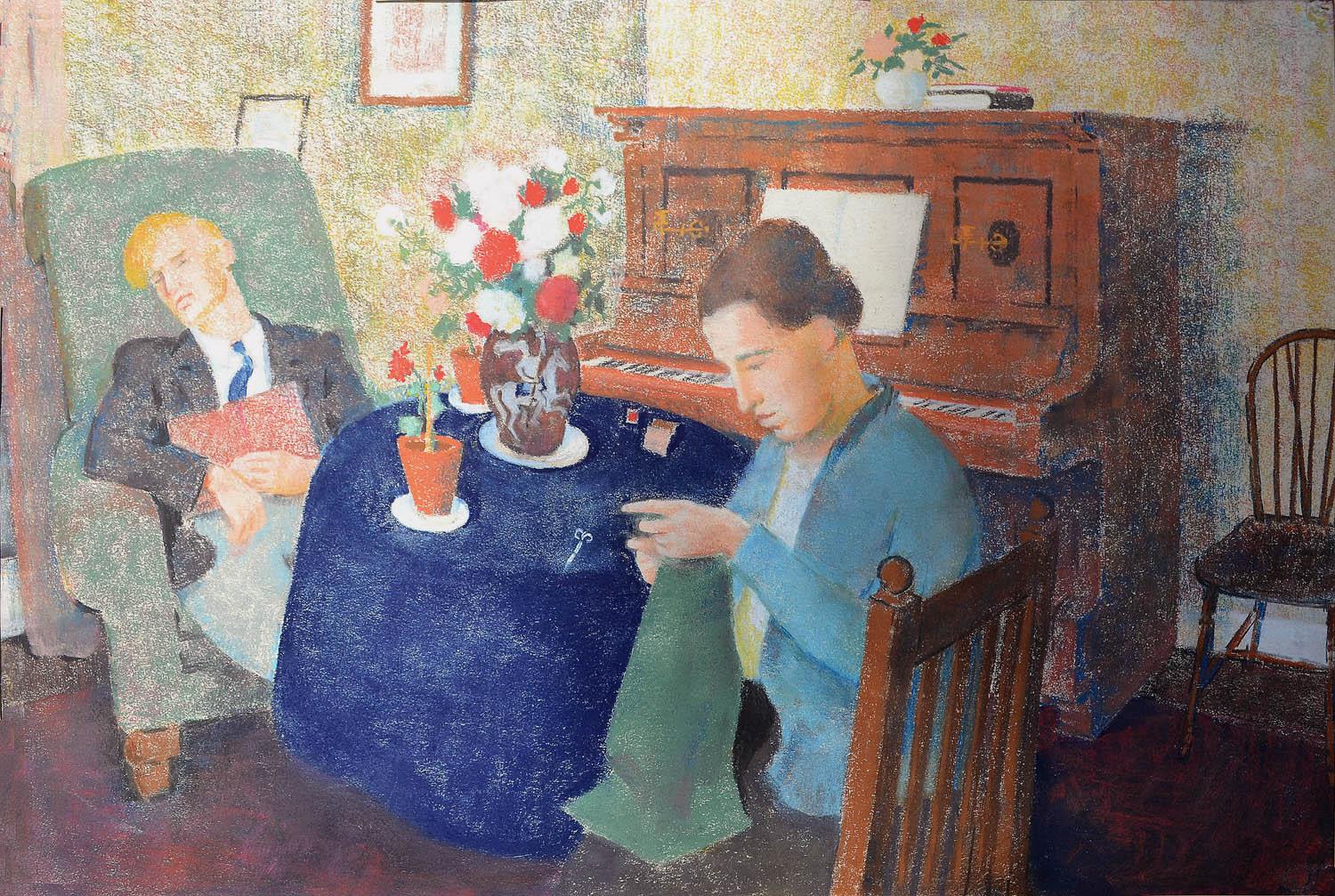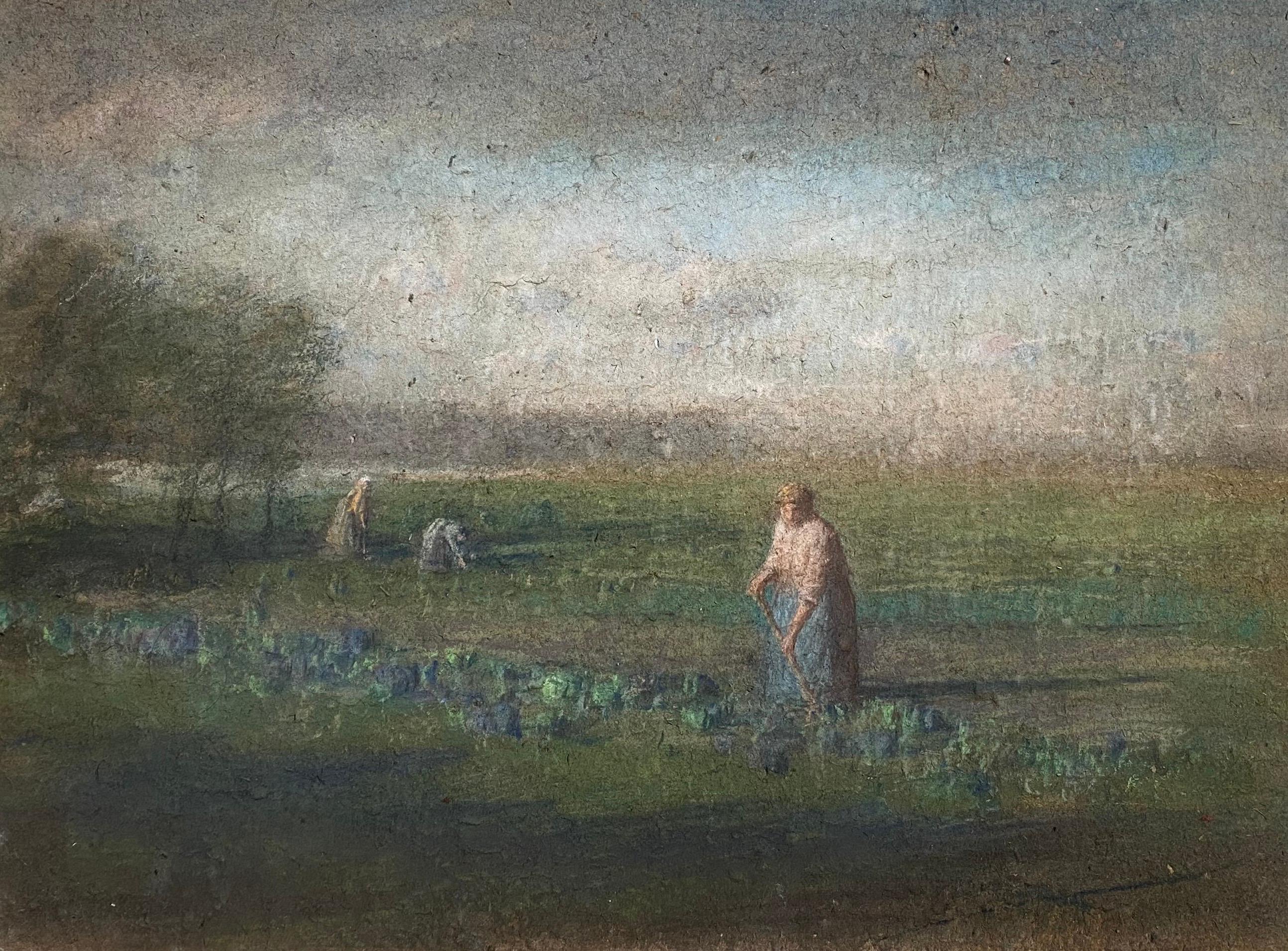Items Similar to Hillside pastel by Allen Tucker
Want more images or videos?
Request additional images or videos from the seller
1 of 4
Allen TuckerHillside pastel by Allen Tucker1918
1918
About the Item
Hillside (1918)
Pastel on grey paper
8 ½"x7 ¾"
23 ½" x 19 ½" x 1 ½"
signed "Allen Tucker March 1918" lower right.
Provenance: Gift from the artist to his friend Una Brage, USA/Switzerland, in the 1930s.
Estate of Ms. Brage to her friend Jean Corbett Peck, daughter of architect Harvey Wiley Corbett.
By descent to her daughter
About this artist: Allen Tucker, was an architect and painter so influenced by Vincent Van Gogh that he was called "Vincent in America". (Gerdts 291) Robert Henri and Maurice Prendergast were also credited as having an influence on Tucker's brushwork and compositions, the latter decisively. However, as his painting evolved, he did not fit into any tidy slot for description and was known as an individualist not easily categorized in American art history.
Tucker was born in Brooklyn in 1866 and graduated from the School of Mines of Columbia University with a degree in architecture and took a job as an architectural draftsman in the architectural firm of McIvaine and Tucker, his fathers business. During that time, he studied painting at the Art Students League with Impressionist John H. Twachtman, but it was not until around 1904, when he was 38, that Tucker became a full-time painter, leaving architecture behind. Many of his early canvases were classically Impressionistic with poplar trees resembling those of Van Gogh and haystacks and corn shocks emulating those of Claude Monet. However, he did not hold to his Impressionist style and explored other kinds of abstraction as well as architectural forms.
He became, in 1911, a charter member of the Association of American Painters and Sculptors, the group that would conceive, organize, select the artists and hang the 1913 Armory Show that shocked many persons by introducing abstract art to America. Tucker helped organize the landmark Armory Show of 1913 and in 1919 was also part of the founding the Society of Independent Artists, a group that rebelled against traditionalism.
In 1918, Tucker had his first large one-man show at the Whitney Studio Club (later the Whitney Museum of American Art) and became an advisor to Mrs. Juliana Force, who directed the Whitney Studio and the Whitney Studio Club. He was an Honorary Member of the Art Students' League, and taught at the League from 1921 to 1928. Tucker also wrote, "Here and There," a book of verse, 1919; "Design and Idea," 1930 and "John Henry Twachtman," 1931. His summers were spent painting in New Mexico, on the New England coast, in the Colorado and Canadian Rockies and in Europe.
Allen Tucker died in New York City in 1939.
His work is in the collections of the Albright-Knox Art Gallery, Buffalo, New York; Art Institute of Chicago; Brooklyn Museum; Metropolitan Museum of Art, New York City; and the Phillips Collection, Washington, D.C.
from David Michael Zellman, "Three Hundred Years of American Art"
- Creator:Allen Tucker (1866-1939, American)
- Creation Year:1918
- Dimensions:Height: 8.5 in (21.59 cm)Width: 7.75 in (19.69 cm)
- Medium:
- Movement & Style:
- Period:
- Condition:
- Gallery Location:Hudson, NY
- Reference Number:
About the Seller
5.0
Vetted Seller
These experienced sellers undergo a comprehensive evaluation by our team of in-house experts.
Established in 1973
1stDibs seller since 2023
6 sales on 1stDibs
Typical response time: 1 hour
- ShippingRetrieving quote...Ships From: Hudson, NY
- Return PolicyThis item cannot be returned.
More From This SellerView All
- Untitled-042 pastel on paper by Hans BurkhardtBy Hans BurkhardtLocated in Hudson, NYHand-signed and dated "H Burkhardt '63" lower right. Provenance: The artist to his daughter Elsa. By descent to her son. Chronology of the artist: 1904 Hans Burkhardt was born in ...Category
1960s Modern Figurative Drawings and Watercolors
MaterialsPastel, Paper
- Untitled-032 pastel on paper by Hans BurkhardtBy Hans BurkhardtLocated in Hudson, NYHand-signed and dated "H Burkhardt '63" lower right. Provenance: The artist to his daughter Elsa. By descent to her son. Chronology of the artist: 1904 Hans Burkhardt was born in ...Category
1960s Modern Figurative Drawings and Watercolors
MaterialsPastel, Paper
- Untitled-039 pastel on paper by Hans BurkhardtBy Hans BurkhardtLocated in Hudson, NYHand-signed and dated "H Burkhardt 1973" lower right. Provenance: The artist to his daughter Elsa. By descent to her son. About this artist: Hans Burkhardt was born December 20th,...Category
1960s Modern Figurative Drawings and Watercolors
MaterialsPastel, Paper
- Untitled-053 Pastel Figure by Hans BurkhardtBy Hans BurkhardtLocated in Hudson, NYHans Burkhardt regularly used live models for his figural pastels, which he maintained an interest in throughout his long career. Untitled (1963) Pastel on paper 24" x 19" Signed an...Category
1960s American Modern Figurative Drawings and Watercolors
MaterialsPaper, Pastel
- Untitled-019 pastel on paper of three nude models by Hans BurkhardtBy Hans BurkhardtLocated in Hudson, NYHand-signed and dated "H Burkhardt 1972" lower right. Provenance: The artist to his daughter Elsa. By descent to her son. Chronology of the artist: 1904 Hans Burkhardt was born in...Category
1970s Modern Figurative Drawings and Watercolors
MaterialsPaper, Pastel
- Spring Landscape acrylic and pastel painting by Fred MartinBy Fred MartinLocated in Hudson, NYExhibited: 1973 San Francisco Museum of Art 2003 Oakland Museum of California "Fred Martin Retrospective" A native Californian, Fred Martin was born...Category
1970s American Modern Abstract Paintings
MaterialsMasonite, Pastel, Acrylic
You May Also Like
- "Rembrandt Artist's Pastells" original pastel drawing by Sylvia SpicuzzaBy Sylvia SpicuzzaLocated in Milwaukee, WIHere, Sylvia Spicuzza has taken the opportunity to create a geometric, crystalline composition of color while testing a set of Rembrandt artist's pastels. Her fractured planes of col...Category
1950s Modern Abstract Drawings and Watercolors
MaterialsPaper, Pastel
- Rare Modernist Hungarian Rabbi Pastel Drawing Gouache Painting Judaica Art DecoBy Hugó ScheiberLocated in Surfside, FLRabbi in the synagogue at prayer wearing tallit and tefillin. Hugó Scheiber (born 29 September 1873 in Budapest – died there 7 March 1950) was a Hungarian modernist painter. Hugo Scheiber was brought from Budapest to Vienna at the age of eight where his father worked as a sign painter for the Prater Theater. At fifteen, he returned with his family to Budapest and began working during the day to help support them and attending painting classes at the School of Design in the evening, where Henrik Papp was one of his teachers. He completed his studies in 1900. His work was at first in a post-Impressionistic style but from 1910 onward showed his increasing interest in German Expressionism and Futurism. This made it of little interest to the conservative Hungarian art establishment. However, in 1915 he met the great Italian avant-gardist Filippo Tommaso Marinetti and the two painters became close friends. Marinetti invited him to join the Futurist Movement. The uniquely modernist style that he developed was, however, closer to German Expressionism than to Futurism and eventually drifted toward an international art deco manner similar to Erté's. In 1919, he and his friend Béla Kádar held an exhibition at the Hevesy Salon in Vienna. It was a great success and at last caused the Budapest Art Museum to acquire some of Scheiber's drawings. Encouraged, Scheiber came back to live in Vienna in 1920. A turning point in Scheiber's career came a year later, when Herwarth Walden, founder of Germany's leading avant-garde periodical, Der Sturm, and of the Sturm Gallery in Berlin, became interested in Scheiber's work. Scheiber moved to Berlin in 1922, and his paintings soon appeared regularly in Walden's magazine and elsewhere. Exhibitions of his work followed in London, Rome, La Paz, and New York. Scheiber's move to Germany coincided with a significant exodus of Hungarian artists to Berlin, including Laszlo Moholy-Nagy and Sandor Bortnyik. There had been a major split in ideology among the Hungarian avant-garde. The Constructivist and leader of the Hungarian avantgarde, Lajos Kassák (painted by Hugó Scheiber in 1930) believed that art should relate to all the needs of contemporary humankind. Thus he refused to compromise the purity of his style to reflect the demands of either the ruling class or socialists and communists. The other camp believed that an artist should be a figurehead for social and political change. The fall out and factions that resulted from this politicisation resulted in most of the Hungarian avant gardists leaving Vienna for Berlin. Hungarian émigrés made up one of the largest minority groups in the German capital and the influx of their painters had a significant effect on Hungarian and international art. Another turning point of Scheiber's career came in 1926, with the New York exhibition of the Société Anonyme, organized by Katherine Dreier. Scheiber and other important avant garde artists from more than twenty-three countries were represented. In 1933, Scheiber was invited by Marinetti to participate in the great meeting of the Futurists held in Rome in late April 1933, Mostra Nazionale d’Arte Futurista where he was received with great enthusiasm. Gradually, the Hungarian artists began to return home, particularly with the rise of Nazism in Germany. Kádar went back from Berlin in about 1932 and Scheiber followed in 1934. He was then at the peak of his powers and had a special flair in depicting café and cabaret life in vivid colors, sturdily abstracted forms and spontaneous brush strokes. Scheiber depicted cosmopolitan modern life using stylized shapes and expressive colors. His preferred subjects were cabaret and street scenes, jazz musicians, flappers, and a series of self-portraits (usually with a cigar). his principal media being gouache and oil. He was a member of the prestigious New Society of Artists (KUT—Képzőművészek Új Társasága)and seems to have weathered Hungary's post–World War II transition to state-communism without difficulty. He continued to be well regarded, eventually even receiving the posthumous honor of having one of his images used for a Russian Soviet postage stamp (see image above). Hugó Scheiber died in Budapest in 1950. Paintings by Hugó Scheiber form part of permanent museum collections in Budapest (Hungarian National Museum), Pecs (Jannus Pannonius Museum), Vienna, New York, Bern and elsewhere. His work has also been shown in many important exhibitions, including: "The Nell Walden Collection," Kunsthaus Zürich (1945) "Collection of the Société Anonyme," Yale University Art Gallery, New Haven, Connecticut (1950) "Hugó Scheiber: A Commemorative Exhibition," Hungarian National Museum, Budapest (1964) "Ungarische Avantgarde," Galleria del Levante, Munich (1971) "Paris-Berlin 1900-1930," Centre Georges Pompidou, Paris (1978) "L’Art en Hongrie, 1905-1920," Musée d’Art et l’Industrie, Saint-Etienne (1980) "Ungarische Avantgarde in der Weimarer Republik," Marburg (1986) "Modernizmus," Eresz & Maklary Gallery, Budapest (2006) "Hugó Scheiber & Béla Kádár," Galerie le Minotaure, Paris and Tel Aviv (2007) Hugó Scheiber's paintings continue to be regularly sold at Sotheby's, Christie's, Gillen's Arts (London), Papillon Gallery (Los Angeles) and other auction houses. He was included in the exhibition The Art Of Modern Hungary 1931 and other exhibitions along with Vilmos Novak Aba, Count Julius Batthyany, Pal Bor, Bela Buky, Denes Csanky, Istvan Csok, Bela Czobel, Peter Di Gabor, Bela Ivanyi Grunwald, Baron Ferenc Hatvany, Lipot Herman, Odon Marffy, C. Pal Molnar...Category
Early 20th Century Modern Figurative Paintings
MaterialsPaper, Charcoal, Pastel, Watercolor, Gouache
- At Rest, 20th Century British Artwork, Pastel Interior with Original FrameLocated in London, GBPastel on paper Image size: 22 x 14 3/4 inches (55.75 x 37.5 cm) Original frame Gordon Scott Gordon Scott was trained at the Royal College of Art (1934-38) under Gilbert Spencer, ...Category
20th Century Modern Interior Drawings and Watercolors
MaterialsPaper, Pastel
- Translucent Boy, 20th Century British Artist, Pastel PortraitBy Peter GardnerLocated in London, GBPastel on paper Image size: 6 x 7 inches (15.25 x 17.75 cm) Mounted Peter Gardner Peter Gardner was born in London in 1921. He studied at the Hammersmith School of Art between 193...Category
Early 20th Century Modern Portrait Drawings and Watercolors
MaterialsPaper, Pastel
- Field Workers, 19th Century Pastel DrawingLocated in London, GBPastel on paper Image size: 13 3/4 x 18 3/4 inches (35 x 48 cm) Gilt frame The scene depicts three woman working in a field in the afternoon. Pastel had fallen out of fashion by th...Category
Mid-19th Century Modern Landscape Drawings and Watercolors
MaterialsPaper, Pastel
- Colorful Cottage - Drawing - Mid-20th CenturyLocated in Roma, ITColorful Cottage is a drawing realized by an anonymous in the mid-20th century. Pastel on paper. Fair condition with a cutting on the left. The artwork is created through deft st...Category
Mid-20th Century Modern Figurative Drawings and Watercolors
MaterialsPaper, Pastel
Recently Viewed
View AllMore Ways To Browse
Collection Of Architectural Drawings
Modern Art Pastel
Drawings By Architects
The Pastel City
Large Architectural Drawing
Antique Drawing Book
Large Art Pastel
Antique Architectural Drawings
Antique Pastel
A Allen
Classical Architectural Drawings
Antique Pastel Art
An Allen
Antique Pastel Painting
Robert Daughters
David Whitney
Buffalo Drawing
Allen Designs





